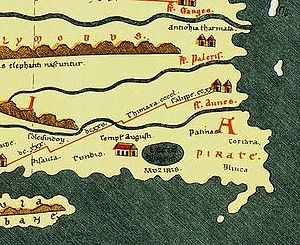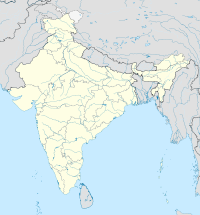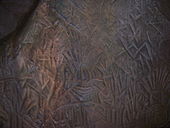- Muziris
-
Muziris
MuccirippattanamLocation Kerala state, India Region Ernakulam district Coordinates 10°54′00″N 76°07′12″E / 10.90°N 76.120°E Type Ancient port Part of Malabar Coast History Founded ca. 1000 BCE Abandoned ca. 1341 CE Site notes Excavation dates Started in 2007 Archaeologists Archaeological Survey of India [ASI], Archaeology Department, Govt. of Kerala Condition ruins Ownership Kerala state. Public access Prior permission necessary for visitors. Website http://www.keralahistory.ac.in/ , http://www.keralatourism.org/muziris/ Muziris (Malayalam: മുസിരിസ്) is an ancient sea-port in Southwestern India on the Periyar River 3.2 km from its mouth. The derivation of the name Muziris is said to be from "Mucciripattanam," "mucciri" means "cleft palate" and "pattanam" means "city". Near Muziris, Periyar River was branched into two like a cleft palate and so the name "Mucciripattanam. "
In a flood of the Periyar River in 1341 CE, Muziris was destroyed and the centre of commerce was shifted to other areas. Soon the exact location of Muziris was forgotten. The multi-disciplinary and multi-seasonal archaeological research by the Kerala Council for Historical Research (KCHR) at Pattanam, a small village at North Parur, is revealing the past of this area and may eventually locate the exact position of Muziris. British Academy (BASAS) recently accorded recognition for the formation of an international research group based on Pattanam.[1]
Contents
Mucciripattanam
Other names that are often used are Muraccipattanam, Mariccipattanam, Mucciri, Vanchi or Muzirikkod. Muziris is referred to as Muchiri in Sangam literature's Akananuru, Murachipattanam in Valmiki's Ramayana, and as Muzirikode in the Jewish Copper Plate of Bhaskara Ravi Varma (circa 1000 CE).[2][3] In his Brihtsamhita Varaha Mihira refers to both Baladevapattanam and Marichipattanam as important towns in Kerala. Kern, Varaha Mihira’s translator, identifies these places with the Baliapattana and the Muziris of Ptolemy and other Greek geographers, respectively. Muziris was also mentioned in the 1st century Natural History of Pliny the Elder, the 2nd century Geographia of Ptolemy, the 2nd century Muziris Papyrus (p. Vindob G480822), and the 4th century Tabula Peutingeriana.
Location
 Muziris, as shown in the 4th century Tabula Peutingeriana.
Muziris, as shown in the 4th century Tabula Peutingeriana. Main article: Pattanam
Main article: PattanamThere has been much research about the exact location of the port. It was long considered to be in Kodungallur in Thrissur district, because all major ports in ancient times were situated at river mouths.
But in 1983, a large hoard of Roman coins was found at a site about six miles from Kodungallur in a small village called Pattanam on the northern shore of Paravur Thodu, a branch of Periyar River. It is in the Chittatukara Panchayat, of Ernakulam District, 2 km north of North Paravur and 25 km north of Kochi. Now this village is one of the most significant archaeological sites in South Asia. The Excavations carried out at Pattanam from 2007 to 2011 have uncovered evidences which may support its being the location of ancient sea-port Muziris.[4][5][6][7]
It is also postulated that the name Pattanam is an abbreviation of what was originally Musiripattanam, the local name of Muziris.
Early descriptions
Pliny the Elder
Pliny the Elder (c. 23- 77 CE) gives a description of voyages to India in the first century CE. He refers to many Indian ports in his work The Natural History. [8]
"To those who are bound for India, Ocelis (On the Red Sea) is the best place for embarkation. If the wind, called Hippalus (Southwest Monsoon), happens to be blowing it is possible to arrive in forty days at the nearest market in India, "Muziris" by name. This, however, is not a very desirable place for disembarkation, on account of the pirates which frequent its vicinity, where they occupy a place called Nitrias; nor, in fact, is it very rich in articles of merchandise. Besides, the road stead for shipping is a considerable distance from the shore, and the cargoes have to be conveyed in boats, either for loading or discharging. At the moment that I am writing these pages, the name of the king of this place is Caelobothras (Keralaputras). Another port, and a much more convenient one, is that which lies in the territory of the people called Neacyndi, Barace by name. Here king Pandion (Pandya) used to reign, dwelling at a considerable distance from the market in the interior, at a city known as Modiera (Madurai). The district from which pepper is carried down to Barace in boats hollowed out of a single tree is known as Cottonara (Kuttanadu).
"Travellers set sail from India on their return to Europe, at the beginning of the Egyptian month of Tybia, which is our December, or at all events before the sixth day of the Egyptian month Mechir, the same as our Ides of January; if they do this they can go and return in the same year. They set sail from India with a south-east wind (Northeast Monsoon), and upon entering the Red Sea, catch the south-west or south."
Periplus of the Erythraean Sea
The Periplus of the Erythraean Sea (c. 60–100 CE) gives an elaborate description of the Tamil country:[9]
"...then come Naura and Tyndis, the first markets of Damirica (Limyrike), and then Muziris and Nelcynda, which are now of leading importance. Tyndis is of the Kingdom of Cerobothra; it is a village in plain sight by the sea. Muziris, of the same Kingdom, abounds in ships sent there with cargoes from Arabia, and by the Greeks; it is located on a river, distant from Tyndis by river and sea five hundred stadia, and up the river from the shore twenty stadia...Nelcynda is distant from Muziris by river and sea about five hundred stadia, and is of another Kingdom, the Pandian (Pandya kingdom). This place also is situated on a river, about one hundred and twenty stadia from the sea...
"There is exported pepper, which is produced in only one region near these markets, a district called Cottonara (Kuttanadu)"
Sangam literature
A tantalizing description of Muziris is in the Akananooru, an anthology of early Tamil poems in the Sangam Literature, poem no. 149 .[10]
"The beautiful warships of the Yavanas come, to the prosperous and beautiful Muchiri (Muziris) splashing the white foams of 'Chulli' ( Periyar River) the big river, and then return laden with 'curry' (Black pepper) paying for it in gold."
Decline and fall
It is not clear, however, why its activities as a major trade port ended and what led to its decline:
- One theory attributes it to an earthquake or the great flood of 1341 recorded in history, which caused the change of course of the Periyar River.
- Experts says that with the fall of Roman Empire this ancient port on the other end of the then known world disappeared mysteriously
- During the Ptolemaic Roman period (third century B.C. to sixth century A.D), Berenike and Myos Hermos for example served as key transit ports between ancient Egypt and Rome on one side and the Red Sea-Indian Ocean regions on the other.[11]. Then other Indian Ocean regions took charge of the commerce and spread it to other seaports of India and South Asia.
Discoveries
A four metre thick soil at Pattanam, conceals the ancient maritime history of the world.
Muziris papyrus
A papyrus document that mentions a loan agreement made by an Egyptian merchant and a merchant in Muziris, for exporting Gangetic Nard, ivorys and textiles was discovered in Egypt in 1980 and first published in 1985. It is now preserved in a Vienna Museum. This second century CE document, is known as the Muziris papyrus or the Vienna papyrus,
That Egyptian merchant gave this agreement to the Roman government as a guarantee for a loan That is how this agreement survived through the ages. This discovery has opened a strong base to ancient international and trade laws in particular and has been studied at length by economists, lawyers as well as historians.[12]
Wharf and a canoe
The most remarkable find in Pattanam is a brick structural wharf complex, with nine bollards to harbour boats and in the midst of this, a highly decayed canoe, all perfectly mummified in mud. The boat 6 meters long was made of Artocarpus hirsutus (Aanjili, in Malayalam), a tree common in Malabar Coast, out of which boats are made off. It was identified by the Kerala Forest Institute, Thrissur.
The bollards some of which are still in satisfactory condition is made of Teak (Texctona grandis). The word teak comes from the language of the Malabar coast, Malayalam word theykku.[13]
The wood of the boat is carbon dated by scientists from Bhuveneshwar institute of physics. Radiocarbon dating using AMS Radio Carbon revealed that the date range of the canoe sample is 1300 BC to 100 BC, (that is, 700 plus or minus 600 BC with 95 per cent probability), making it the earliest watercraft excavated from an archeological context in India.
Archaeological excavations
Part of a series on the History of Kerala Pre-history Pre-history of Kerala
· Edakkal Caves · MarayurSangam period Sangam literature Muziris · Tyndis Economy · Religion · Music Early Cheras Early Pandyas Ezhimalai kingdom Ay kingdom Saint Thomas Christians Medieval age Kalabhra interregnum Mappila Later Cheras Kulashekhara Alwar Adi Shankara Medieval Chola Empire Zamorins of Calicut Venad Kolathunad Kingdom of Travancore Kingdom of Cochin Kerala school Vijayanagara Empire Modern age Vasco da Gama Dutch East India Company Travancore–Dutch War Battle of Colachel Mysore invasion Pazhassi Raja British East India Company Madras presidency Third Anglo–Mysore War Velu Thampi Malabar Rebellion Punnapra-Vayalar uprising Narayana Guru Travancore-Cochin Indian independence Madras State Kerala Communist Party of India The archaeological work done in the area has revealed fragments of imported Roman amphorae, mainly used for transporting wine and olive oil, as well as Yemeni and West Asian pottery and Indian roulette ware, which is also common on the East Coast of India and also found in Berenice in Egypt.[4][5][6][7] This suggests that Muziris was a port of great international fame and that South India was involved in active trade with several civilisations of West Asia, the Near East and Europe.
Researchers seem to agree that the port was already a bustling center of trade by 500 BCE, and there is some evidence that suggests that Muziris was a city, if not a port as well, from before 1500 BCE.[14][15][16][17]
The site for archaeological research at Pattanam (10°09.434’N; 76°12.587’E) covers about 45 hectares. Due to habitation activities it is a disturbed site; some parts are partially destroyed due to sand quarrying. The site seems to have been first occupied by indigenous population around 1000 BCE and continued to be active till the 10th century CE.
The archaeological excavations have unearthed signs of early Roman trade and commerce in beads and ornaments from this hamlet, indicating that this hamlet was part of Muziris. Excavated antiquities include Chera coins, amphorae, terra sigillatta, cameo blanks made of semi-precious stones and large quantities of stone and glass beads. The excavations from 2007 to 2009 produced the largest number of Mediterranean amphora fragments outside the boundaries of the Roman Empire. In 2010, antiquities of small size – beads of both semi-precious stones and glass, pendants and lockets,[18] cameo blanks, coins (predominantly early Chera coins with symbols of an elephant, bow and arrow), objects or fragments of objects made of iron, copper, lead and occasionally gold, and shards of Indian and foreign pottery were excavated. A broken rim with Brahmi script has been found, the first pre-firing pottery inscription found at Pattanam. Enormous quantities of local pottery of the early historic period, dated between the 1st century BCE and the 4th century CE, shows that this was the period of peak activity at Pattanam. A Tamil-Brahmi script with the letters "a ma na," meaning Jaina, was found at Pattanam in 2011. The letters are followed by two megalithic graffiti symbols which could not be identified. This discovery establishes the prevalence of Jainism on the west coast from at least the 2nd century CE.[19]
Project Muziris Heritage
The project was launched by the Department of Cultural Affairs, Govt. of Kerala. It aims to retrieve the historical heritage of the N. Paravur-Kodungallur region and plans a combination of heritage management initiatives in its restoration, conservation and access to the public. KCHR, identified as the nodal agency for Muziris Heritage Project, provides academic guidance and undertakes archaeological and historical research in the region. KCHR Chairman Dr. K. N. Panikkar has submitted a concept note on Muziris Heritage Project pointing out the possibilities and potential of the proposal.[20]
References
- ^ http://www.basas.org.uk/groups/ports.htm (http://www.hindu.com/2009/03/20/stories/2009032054890700.htm
- ^ http://www.commodityonline.com/ndtv/commodities/commoditynewsdetails.php?cat=11&id=5594
- ^ http://www.simaqianstudio.com/forum/index.php?showtopic=3773
- ^ a b "Search for India's ancient city". BBC News. 2006-06-11. http://news.bbc.co.uk/2/hi/south_asia/4970452.stm. Retrieved 2010-05-19.
- ^ a b http://www.hinduonnet.com/2004/03/23/stories/2004032303340500.htm
- ^ a b "Hunting for Muziris". The Hindu (Chennai, India). 2004-03-28. http://www.hindu.com/lf/2004/03/28/stories/2004032800050200.htm.
- ^ a b "Excavations highlight Malabar maritime heritage". The Hindu (Chennai, India). 2007-04-01. http://www.hindu.com/2007/04/01/stories/2007040106021000.htm.
- ^ First English translation by Philemon Holland
- ^ The Periplus of the Erythraean Sea, 53-54
- ^ Kulke 2004: 108
- ^ Muziris papyrus, discovered in 1980
- ^ For the full text in Greek and its translation, see http://www.uni-koeln.de/phil-fak/ifa/zpe/downloads/1990/084pdf/084195.pdf
- ^ Chambers, W. 1875. Chambers's Etymological Dictionary of the English Language. London. p. 513.
- ^ http://www.samachaar.in/Delhi/Trade_links_of_Kerala_city_date_back_to_500_BC_19220/
- ^ "Study points to 500 BCE Kerala maritime activity". The Hindu (Chennai, India). 2008-01-09. http://www.hindu.com/2008/01/09/stories/2008010956451300.htm.
- ^ http://www.orientalthane.com/archaeology/news_2008_01_30_4.htm
- ^ http://indiatoday.intoday.in/index.php?issueid=&id=3689&option=com_content&task=view§ionid=21
- ^ link http://beta.thehindu.com/arts/history-and-culture/article244338.ece?homepage=true)
- ^ "Tamil-Brahmi script found at Pattanam in Kerala". The Hindu (Chennai, India). 2011-03-14. http://www.hindu.com/2011/03/14/stories/2011031453981800.htm.
- ^ Kerala Council for Historical Research [KCHR -> Research Projects ]
See also
- Pattanam
- Kodungallur
- Thiruvanchikulam
- North Paravur
External links
- BBC report, Search for India's ancient city
- Pattanam Excavations (Comprehensive Resource)
- Pattanam Muziris Maps and Excavations
- Ancient Muziris Story
- Pattanam excavation significant
- http://www.wikimapia.org/#lat=10.1571922&lon=76.2096047&z=18&l=0&m=b Current Excavation Site
- http://www.ias.ac.in/currsci/jul252009/236.pdf
- http://www.indianchristianity.com/html/Books.htm
- Dr. Nagaswamy R., 1995, Roman Karur [1]
- Raghava Aiyangar, R.,1932, Vanci Managar, Madras.
- [2]
- Current Excavation Location [3]
- http://beta.thehindu.com/arts/history-and-culture/article472072.ece?homepage=true
Categories:- Ancient India
- Villages in Ernakulam district
- Lost cities and towns
- Former populated places in India
- History of Kerala
Wikimedia Foundation. 2010.



